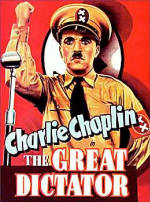Strand 5: Teaching techniques and approaches

 |
The shock of the new |
If your students pretty much know what's going to happen in every lesson you teach, it may be time to experiment with a few unusual techniques and approaches.
You would imagine that a quick search of the internet for something like
'teaching techniques in ELT' would produce a rich harvest of interesting
and effective ideas, wouldn't you?
Well, you'd be wrong. In fact what you get is a mishmash of
confused ideas ranging from fully-fledged methodologies, through
approaches to simple fun and games. The distinctions between
methods, methodologies, techniques and approaches is little understood
out here in the cyber world.
The following assumes that you can do most of the teacherly things that we all do: elicit, use a recorded text or a video, handle a reading text, run a find-someone-who activity, present new language and so on. Here are a few ideas with which to pepper your lessons to make them a little less predictable and a bit more exciting.
A word of warning, however:
Any novelty, if carried on too
long, will trigger adaptation. No matter how exciting and
productive the innovation, people will tire of it. They no
longer respond. It is important to neutralize adaptation by
switching continually from one activity to another.
James Asher (exact source obscure)
There are two areas of this site that contain some interesting and unusual ideas for lessons:
- Warmers, life-savers, fillers and coolers. Many of these may be familiar to you, some may be new and some you may have forgotten about. You can access the list and the ideas here.
- Alternative methodologies. This guide briefly covers The Silent Way, Total Physical Response, Community Language Learning, (De)suggestopedia and Dogme. The guide also provides you with some links to see the approaches in action and learn more. Click here to go there.
Here, we'll suggest some others you may know or may not know about.
It has often been said that teaching techniques are a bit like jokes:
many people know them but nobody knows where they come from. If
you can lay claim to having invented any of the following, let
ELT Concourse know and, if
the claim is credible, you'll be credited.
Click on any of the following to go to the part that interests you.
 |
Dictation ideas Dictation is a neglected but useful technique. Here are some ways to make it more student centred. |
Dictogloss
This is a powerful technique which is intended to get students listening, talking, writing and working on grammar and lexis simultaneously. It can be used as a revision exercise or to introduce a lesson (especially one which involves a written text). Here's how it works
- Select a text which is challenging but not too difficult for
your group. You could use:
- the first part of a text which will form the basis of a lesson
- an invented text which is relevant to the lesson's topic
- text that the learners have worked on in the past but whose features need revising
- Read the text at more or less normal speed. In this phase the students only listen to get the general gist of the text. You may have to repeat this stage.
- Now read the text again at more or less normal speed. In this phase, the learners can take quick notes of key words and phrases. You are reading it too quickly for them to write it down as in a 'normal' dictation.
- Put the class into small groups. Their task is to reconstruct the text as well as they can by combining their memory of what you read. In this phase, you are not inactive. You need to be on hand to help and nudge but not to give them the right answers. If something they have written is grammatically impossible, for example, then you could point it out. If, on the other hand, they have selected a word which is not in the text but is a fair synonym, leave it alone.
- Optionally, you can extend this stage by recombining the groups so that they can draw on other people's ideas. This is usually what's done.
- Now you can do a number of things:
- Hand out or project the text and get them to compare their answers with the original
- Re-read the text slowly for them to note differences
- Give the full text to one member of each group who reads it to the others while they check
- Get one learner to read the text to the whole class while they check
- Finally, focus on the language, especially any areas of grammar or lexis which will be relevant to the rest of the lesson or which need revising.
Running dictation
- Select a text as above.
- Make 3 or 4 copies of the text and stick them to the wall around / near your classroom.
- Put the class in groups of not more than 4. Pairs is fine.
- Instruct as follows:
- Members of the group take turns to go to the text, read and remember as much of it as they can and return to the group
- When they come back, they dictate what they have remembered and the group write it down. Everyone in the group must make a copy of the text.
- The next runner then does the same with the next piece of the text
- Runners may not:
- shout out the text before they have returned to the group
- take notes
- You can make this as competitive or as cooperative as you please.
Note: if you have a class of children or teenagers, you may like to
make this a walking rather than running dictation. Add a rule
forbidding running.
If you want to add an element of challenge, try putting the text further
away (say, down a flight of stairs) because this increases people's
motivation to remember longer sections.
Shouting dictation
With young, exuberant or excitable groups, this can get very noisy. It encourages focus on listening and disregarding background noise among other things.
- Select a short text. Twenty words is quite enough.
- Arrange the class in two straight rows, sitting opposite each other.
- Give the text to the people in one row only.
- The task is to dictate the text to their opposite number who has only to listen to the person directly opposite and try to ignore all the other noise.
- Again, you can make this as competitive or as cooperative as you please.
The mechanical teacher
In this technique, the learners control the speed and frequency of the dictation.
- Select a slightly longer text (say 100 words) which is difficult but not impossibly challenging.
- Arrange the class as individuals, pairs or groups as you like
but each individual, pair or group will only get one each of the
following cards to hold up when they want to:

(You can copy that image, if you need it, and cut it up.) - Carry out the dictation as a 'normal' dictation but allow the students to make a sound (such as Bleep!) whenever they want you to stop or do something else. They need to make a sound to alert you to look up from the text you are reading.
- Obey all commands.
Bleeped dictation
This technique is useful for focusing on particular words or constructions you have presented and practised before. It is a practice technique, not teaching.
- Select a text which contains multiple examples of the language targets. This can be a new text or one from a previous lesson.
- Highlight all the target items. These can be single words, complex tense forms or whatever you choose. It works well for articles, modal auxiliary verbs and prepositions, for example.
- Conduct the dictation as normal but, each time you come to a highlighted item, insert Bleep! in its place. The learners' task is to insert what the item should be.
Ordering dictation
This is a simple technique to make students listen to each other and perhaps focus on sequencing or other cohesive devices (we have avoided the term discourse marker here because it has lost all utility, being used loosely for any item which contributes to coherence or cohesion).
- Choose a text and cut it into 4 or 5 logical sections.
- Arrange the class in groups of four or five and give each student one part of the text.
- The learners' task is to reconstruct the text in its entirety without showing the text to each other. In other words, they have to read out and re-read their part of the text for others to decide if it follows or precedes the section they have.
Whoops dictation
- Select a text as you would normally, making sure it contains some targets of recent lessons.
- Go through the text and replace some of the words with words
that do one of the following. You can mix types but that makes
the exercise very challenging indeed.
- make no sense in the context
- sound similar to but are not the same as the word you have removed (think-sink, raise-rise, commute-compute etc.)
- don't collocate in the same way as the word you have removed (strong vs. heavy rain, make vs. do etc.)
- Dictate the text as normal. During the dictation phase or after they have written the full text, the learners' task is to spot the mistakes and correct them.
Transformation dictation
This is challenging.
- Select a suitable text which can be transformed appropriately.
- Dictate the text but instruct the learners working individually
to transform certain items. For example:
- replace all adjectives with an opposite one (pretty house : ugly house, tall man : short man, marvellous : hideous etc.)
- change all verb + preposition /adverb units to their opposites (came in : went out, put down : picked up, put off : brought forward etc.
- make all present tenses past
- replace all Latinate verbs with multi-word verbs or vice versa (cancel : call off, split up : separate, reduce : turn down etc.
- When it's done, get the students to compare their answers while you monitor and focus on the targets, explaining as you need and teaching / drilling.
 |
There are guides on this site to using visualisation in the
classroom for a range of purposes.
|
For more, try these guides (new tab):
- Using visualisation to prepare for teaching
- This guide is in the Delta section of the site and intended to help people prepare for an assessed lesson. The principles can be applied to any lesson or part of a lesson.
- Using visualisation to help learners
- This covers both the use of visualisation in the classroom as a reinforcement and personalisation technique and for ways learners can use visualisation to help them imagine language encounters and feel better prepared and more confident.
 |
Drilling has its detractors. |
There is
a guide on this site to types of drills. Go there for
a reminder of things like repetition, substitution and
transformation drills and the difference between meaningful and
meaningless drills. The page will open in a new tab so just shut it to come back to this guide.
Here are some other ways to make drilling more interesting and effective.
Backchaining
Actors often learn their lines by breaking up the part and learning the last section first. Dog trainers sometimes teach the final part of a command before the beginning and so do animal trainers in circuses. The theory, such as it is, is that the learners focus on the form not the meaning of what they are doing.
The procedure is simple. Instead of drilling the whole of a long word, phrase or sentence from the beginning, start at the end. E.g.:
- Don't drill: inde > indepen
> independent > independently
Drill instead: ently > pendently > dependently > independently - Don't drill: I would > I would love
> I would love t' come
Drill instead: t' come > love t' come > would love t' come > I would love t' come
Try it. It works.
Who to drill
Many teachers confine themselves to drilling the whole class together
or drilling individuals only.
The problem with drilling the whole class, especially if it's large, is
that a) you can't hear everyone and b) people don't start and finish
together so you get an overlapping cacophony.
Here are some alternatives:
- Drill in small groups. If you have island tables in the room, that's easy. If you have rows or sides of a rectangle, drill one row or side at a time. It's easier for you and the learners to hear if they are getting it right.
- Drill males and females separately. The mixed voice tones when they speak together make it difficult to hear what's right and wrong.
- Select groups to drill randomly (or, actually, quite carefully):
- give everyone a letter and drill all the Bs, all the Ds etc.
- everyone wearing something red
- everyone wearing jeans
- everyone over 25
- everyone who drank coffee at breakfast time
etc.
- After you have modelled the target, get a learner to do the group selection or decide who should repeat.
The vanishing-text drill
This gives lots of intensive practice without it becoming boring.
Interactive whiteboards are ideal for this but you can do it with any
board. Here's how it works:
- Write a short text on the board.
- Read the text aloud and drill it. You can backchain it for greater focus, and drill in groups (see above).
- When the learners' production is satisfactory (and not before), erase two or three words.
- The learners have to repeat the whole text, remembering what goes in the gaps.
- Repeat this until the learners are repeating the whole text with no cues on the board at all.
The growing-text drill
Lots of people reserve drilling for pronunciation work with
individual sounds or word stress but it can be
challenging and motivating to drill larger chunks of language which
require the learners to recognise and reproduce sentence stress, rhythm,
timing, phrasing, contractions and weak forms accurately.
One of the main characteristics of English sentence stress is that we
usually emphasise the final elements in an utterance because that,
conventionally, is where the new information lies.
You can start with a short sentence such as I came home
where the final element is stressed and
work up to:
- I came home and found a cat
- I came home and found a cat on my doorstep
- I came home and found a tiny cat sitting on my doorstep
- I came home and found a tiny cat sitting on my doorstep looking lost
- I came home and found a tiny cat sitting on my doorstep looking lost and hungry
- I came home and found a tiny cat sitting on my doorstep looking lost and hungry so I took it in
- I came home and found a tiny cat sitting on my doorstep looking lost and hungry so I took it in and gave it something to eat
Students enjoy the challenge but you need to be alert to their
production of the language, especially stress, intonation, timing and
weak forms as you go along. You may need to stop frequently and drill
sections of the text.
If you have an interactive whiteboard you can prepare this in advance
and have the models marked with the stress and intonation patterns.
 |
It is not only young learners with short
attention spans who like to move around in the classroom. |
There is, incidentally, some evidence that physical movement induces the body to make dopamine, a chemical which increases our ability to see patterns and learn.
Here are some simple examples of ways to get people moving.
- Checking answers
- Instead of checking the answers to tasks in pairs with the person sitting adjacent, ask people to move around or mingle in groups.
- Getting feedback from True/False exercises
- Instead of asking people what they thought, get people to stand up if they thought the answer to an item was false and remain seated if they think it's true, or vice versa.
- Stress
- Instead of drilling people in their seats, get them to stand up when they say the stressed syllable or word.
- Feedback
- Instead of just eliciting the answers to a task, think about whether the learners can come to the board individually and write their responses.
- Brainstorming
- We often ask learners to think about a topic in order to activate what they already know by, say, coming up with a list of words or a set of ideas. There's no reason why they can't write the lists on the board in teams.
Try some Total Physical Response techniques. For more, go to the guide on TPR.
 |
Gauging progress |
There's a separate guide in this section of the site to gauging and measuring progress in your development. Go there for more ideas.
One simple way to gauge whether using some of these techniques is helping is to see if you think it made any difference to your learners' ability to remember and produce language.
Another way is to ask them, of course.
If you have another issue with teaching techniques that you would like some advice about, contact ELT Concourse and we'll see what we can do to help.
